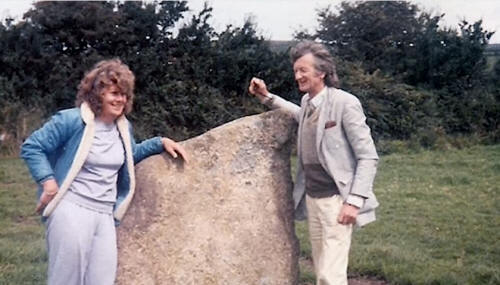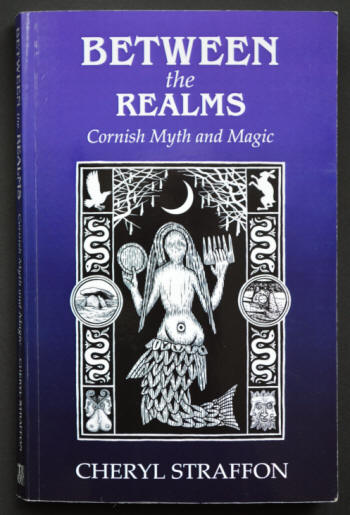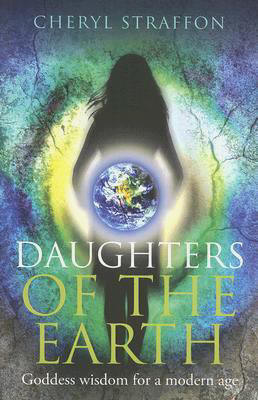|
|
| home | features | exhibitions | interviews | profiles | webprojects | archive |
|
Cheryl Straffon on earth mysteries, Meyn Mamvro and the Goddess Cheryl Straffon is an author and editor of Meyn Mamvro and Goddess Alive magazines. She lives in West Cornwall.
Can you say something about your childhood and education? I moved to
Cornwall when I was about three and I was brought up in Calstock in the
Tamar Valley. At that time it was very cut off. The village was very
isolated and very insular. He was giving an evening class on some of this material and so we became friends. It (the class) was in Kensington. He came down to Cornwall soon after me. He and Charla lived in Penzance and we worked together on various things. I got involved in The Dragon Project. And we put on one of the Ley-hunter Moots down here. Paul was in Cornwall about ten years. Can you say more about The Dragon Project? Paul started it when he was in London, then carried it on when he was down here. Some of the work was looking at the strange and anomalous experiences that people have at the sites. So they were using magnetic readings, ultrasound, geiger-counter readings and so on. Paul wrote this up in his book 'Places of Power', and I wrote it up in 'Megalithic Mysteries in Cornwall'. Paul was also researching whether there were site-specific dreams. There were three sites chosen. One was Chun Quoit, where the archeologist Brian Larkman had observed little coloured lights running underneath the capstone. Another was Madron Baptistry because people had reported hearing pan-pipes and voices there, and the third site chosen was Carn Euny fogou because people had reported altered states of consciousness in the fogou. I took part in one of the dream sessions at the fogou. Did Paul continue as editor of the Ley-hunter when he was in Cornwall?
He eventually handed over the editorship to
Danny Sullivan. There was a whole area of controversy at the time that
coincided with the rise of dowsing, and people like Hamish Miller who
was living in Lelant. He did, and it was a very influential book which affected a lot of people. The whole idea of The St Michael line, which was an energy line connecting Michael sites up through Britain, came into the public consciousness through the work of Hamish and Paul. And people still talk about it now as if its an actual fact. But it isn't, these sites only align on a map, and these Michael sites do not actually align. But it's a key to unlocking the mind and way to enter an alternative reality. That's how I see dowsing. Lana my partner is a good dowser. We might use dowsing to help discover sites or stones that have been lost.
I was used to the idea of a regional Earth Mysteries magazine. When I came down (1986) I looked around and was surprised that there wasn't one for Cornwall. So that's why I set it up. I had no idea it would go on for 30 years. There were a few people who were interested in these things, but they were not connected at that time. I was also interested in the spirituality of the sites, in terms of the people who built them and how they were used originally for ritual or ceremony. And it related to my own spirituality. I was defining as pagan and beginning to define as Goddess. There were the Earth Mysteries magazine and Paganism magazines, and I brought both into Meyn Mamvro and it seemed to touch a nerve. It brought together all these isolated people who started to subscribe, and write for it and link up with each other. Andy Norfolk contributed a lot of the artwork for example... He's also an architect. He was the ideal choice for the covers, though in fact the first covers were done by Gabrielle Hawkes, wife of Tom Henderson Smith, who had Visions and Journeys Gallery in St Just. Andy and I were the two people who got the CEMG (Cornwall Earth Mysteries Group) off the ground. He got CASPN (Cornwall Ancient Sites Protection Network) established around 1999 at the time of the solar eclipse when there was a lot of concern that the sites would get damaged. When Andy resigned as chair I took it over and its become a big part of my life. Coming back to the origins of Meyn Mamvro, in what sense were you defining as Pagan? I was always interested in other religions. I was not brought up as a Christian. My parents were atheists. But I was always interested in a spirituality that was earth-connected. If I had to be labelled, in my younger days, I was a pantheist, like the Romantic poets who saw spirit in nature everywhere. But the sixties saw the rise of the Neo-Pagan movement, which was still quite hidden. It (witchcraft) had been completely illegal in the previous decade. When I was growing up there was no access to it. Now there are thousands of books on it, but when I was growing up it was hidden. The turning point was an evening class in London with Ken Rees called 'Witchcraft, magic and myth' or something like that. All the proto-hippies that went, would go to him and ask where they could join a coven. We used to meet in the pub afterwards, and we would chat. One day Ken called me at work. He said 'I was very interested in what you were saying in the pub. Would you be interested in coming to something in Highgate woods? Bring some good walking boots and a candle in a jar'. I agonised as to whether I should go, but I did and it was working coven, a spin-off of the Regency coven that met there. This was my first experience of ritual and it blew me away. This would have been mid-late 70's? Yes. I stayed with them for a year and a day, and learnt all the basics. Then I left, and started running my own group, and Ken was part of that for about a year. Then I moved down to Cornwall and discovered there was one other person who was as experienced as I was, and in fact I was introduced to him, Jo O'Clereigh, by Ken. Jo was living in the woods in Lamorna. Jo and I worked together and attracted other people who were interested as well. I noticed Jo wrote for the first edition of MM... Jo wrote on milpreves for the first edition of MM. Jo actually first got me into Goddess spirituality. He'd got hold of a book 'Gods and Goddesses of Old Europe' by Marija Gimbutas, who wasn't known over here at that time. When I read it, it blew me away. I had no idea that worship of a Goddess went back 30,000 years and that there was so much evidence for it that had been suppressed or minimised up until then. Gimbutas influenced so many others particularly American women researchers who did a lot of reclaiming of these Goddess cultures. Miriam Dexter and others brought out books that were right in the line of what I was interested in. This was the whole rise of the Neo-Goddess movement both in America and in this country. So the two strands of the influence has been the sacred sites, but also Goddess spirituality. They came together in the two magazines that I've edited. 'Meyn Mamvro', and 'Goddess Alive' which started in 2001 I think.
I was motivated by the fact that all the histories of Cornwall that I'd read were based on hierarchy, battles and killing and I didn't see Cornwall that way. But archeologists were not looking at spiritual practices and beliefs then. They are now, and they're discovering things that we were talking about 20 or 30 years ago. In fact down here the Cornwall Archeological Unit was always more open. Charles Thomas who was the county archeologist, was very open to alternative ideas. He has always subscribed to MM and still does. Peter Herring was another one who was very open. Craig Weatherhill had already produced the book Belerion (1981). He is another architect by training. Ian Cooke had not published at that stage but subsequently produced a book on fogous. He published his early research in MM. There were a few people like that around who I could trust, because of their knowledge. There is a different generation of archeologists around now who, are much more open to the spirituality of the landscape. Which must relate to changing attitudes towards paganism... I was brought up in an age that was homophobic and anti anything that might not be Christian. I've seen the world change 360 degrees. So there's been an extraordinary shift in my life. Fogous, these amazing prehistoric subterranean chambers, are almost unique to Cornwall Most accept that fogous were sites for ritual and ceremony. Ian (Cooke) noted that most fogous are aligned to the North East and the rising mid-summer sun. Sun, moon and star alignments of the ancient monuments are now accepted by archeologists. To me, the reason they constructed their monuments so carefully had to be because they were celebrating the Earth Goddess, and the bounty of the earth, and the one that fed them at the times of the lowest and highest points of the year. We're talking Iron Age, so its late. This is the Celtic period now. And we know there is a whole range of Irish and Welsh material describing this period. By the time the Cornish material was written down it had become quaint stories of saints or witches. I've been working towards writing 'Between the Realms' (above right) for about 30 years . It's about the material from folklore and legends, from people like Bottrell and Hunt. Underneath the stories, is a bedrock of the same material prevalent in the Welsh and the Irish stories about people's experience of the Spirit World or Otherworld and the beings that frequented it. That book was the most difficult and the most satisfying to write. I was thrilled because it had an excellent review from Alan Kent, who really understood it. Coming back to fogous, I was interested to think about how the they might have been used. We know the fogous were blocked at both ends, and you entered by crawling on your belly down a little creep passage. Which may have been an initiation ritual. Perhaps they crawled into darkness, which would have been conducive to altered state of consciousness aided by fasting, dancing and drumming, and ingestion of psychotropic substances.
We were friends. We met at the Ley Hunters Moot in 1990. She was on the first ever Goddess tour to Britain that was run by an American called Lydia Ruyle and Julie Felix, the English singer. Monica did the tour of Wales, where she lived, and I did the tour of Cornwall. There was a big overlap in our beliefs and interests. But she was not an easy woman. Anybody you talk to about her will say the same. But she was a Goddess-celebrating woman, with good political beliefs. She said she got a lot of flak for 'God Giving Birth' (left). She picketed the Cathedral and was roundly condemned by most pagans. But she put her money where her mouth was. To me, politics and spirituality should go together. The British and US Goddess movements had different paths. A lot of the British women were involved with Greenham Common. There was a great schizm really because a lot of the political women's movement were sceptical about the Goddess movement. We were a minority. How were pagan practices evolving during this period? I'm thinking of Starhawk here for example Starhawk was an American with British connections. She was part of the reclaiming collective, which had branches in different places. My previous partner and I came together through an interest in creating Goddess-based ritual. She had had training with Starhawk, I had come via straight paganism. When we came together it was hugely creative because we both brought different but convergent spiritual practices. We were both interested in embodiment, which was an ancient Cretan technique, where a priestess would embody the Goddess. And so we both started to create ritual around that. I've
written about this in the early issues of Goddess Alive. We created a
Goddess wheel of the year, and a
When we devised this wheel of the year, it felt natural to go to places in the land where you could celebrate. We would use Carn Euny for the Samhain ritual, which is modern day Halloween. It was a time in Celtic myth when the Otherworld was very close. At the winter solstice we have used a local fogou down here in Boscaswell. After sleeping the dreamless sleep we go down in the darkness to call back the Goddess of light out of the fogou who will return with the first light. The celebration of Imbolc is always about the return of Brigit. Brigit was a Saint, and before that was a Goddess. Up until the beginning of the century, children would gather flowers and shells and the mother or father would make an effigy. On Imbolc eve they would go to the back door of the house and they would call Brigit in, and her spirit would enter this effigy and they would offer her butter and cut the cloth that she was wrapped in. And this cloth was used for healing purposes for the rest of the year. We have tried to base the ceremonies on myth. Myth is a way of encapsulating these beliefs. It's written up in 'Daughters of the Earth'. Given all your work on reviving Cornish folklore and myth, and bringing it alive, have you been invited to join the Gorseth? The Cornish Gorseth is primarily Christian. The founders of the Cornish Gorseth came from a Methodist or Christian background. They've always been wary of Paganism or Druidry. So I think my background would preclude me. But I am thrilled that what I have written has inspired people. That's the only recognition I need. I'm happy with my life and I'm proud of what I've done. And I'm amazed that other people have enjoyed it.
|
|
|




 Celtic
Goddess wheel of the year. I think we were creating something quite new.
Celtic
Goddess wheel of the year. I think we were creating something quite new.